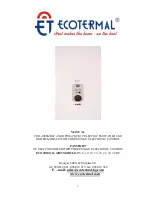
7
A flue system must be provided in accordance with
BS5410:Parts 1& 2 and the current Building Regulations.
7.1 CONVENTIONAL FLUE (CF).
See Fig. 3.
Conventional Flue Diameters: 12/18 – 100 mm (4 in.)
18/25 – 100 mm (4 in.)
NOTE:
External flues systems must be of the insulated flue type.
The boiler is fitted with a conventional flue locating spigot. The
flue pipe fits into the spigot and should be correctly sealed with
fire cement.
NOTE:
The size of the flue must never be reduced from the take-
off diameter. An increase in flue size is permissible provided that
the joint is sealed correctly.
When installed the flue should be vertical and contain as few
bends as possible. Where bends are necessary, a maximum of
two are permitted and 135 degree bends should be used.
All brick and masonry chimneys should be lined with a suitable
non-combustible material, properly jointed and able to with-
stand the effects of the working temperature of the appliance
and any condensate which may form.
Down-draught conditions will adversely affect the operation of
the boiler and must be avoided. Where possible the flue should
be extended beyond the apex of the roof and should always be
taken beyond the eaves of the building. Where down-draught is
experienced a suitable anti down-draught terminal should be
fitted to the flue termination.
The natural flue draught must be checked in the flue pipe imme-
diately above the appliance or in the hole provided in the flue
outlet plate. The flue draught should be no less than 0.75 mm
W.g. and no greater than 5.1 mm W.g. If a flue draught greater
than 5.1 mm W.g. is experienced a draught stabiliser should be
introduced into the flue and adjusted to achieve a flue draught
within the specified range.
7.2 ROOM SEALED BALANCED FLUE MODEL (RS).
The appliance is supplied ready for installation as a room sealed
balanced flue system by the simple addition of one of the flue
terminal kit options.
Details of the installation procedure are included in the Flue
Terminal Instructions supplied with the terminal kit..
7.3 Siting the flue terminal
1.
The flue terminal must be located in a suitable position, such
that the products of combustion can be freely dispersed without
the possibility of the gases entering the dwelling or that of a
neighbouring dwelling.
2.
Discharge of flue gases into car ports or narrow passageways
is not recommended.
3.
The terminal must not cause an obstruction nor the discharge
cause a nuisance as a result of either flue gases or terminal noise.
4.
If the terminal is fitted within 1 m of a plastic or painted
gutter or within 500 mm of painted eaves then an aluminium or
stainless steel shield at least 1 m long should be fitted to protect
the surface.
5.
Take care to ensure that combustion products do not enter
ventilated roof voids.
7. Flue System
Fig. 3. Flue Installation.
Summary of Contents for DANESMOOR FS12/18
Page 27: ...27 ...








































